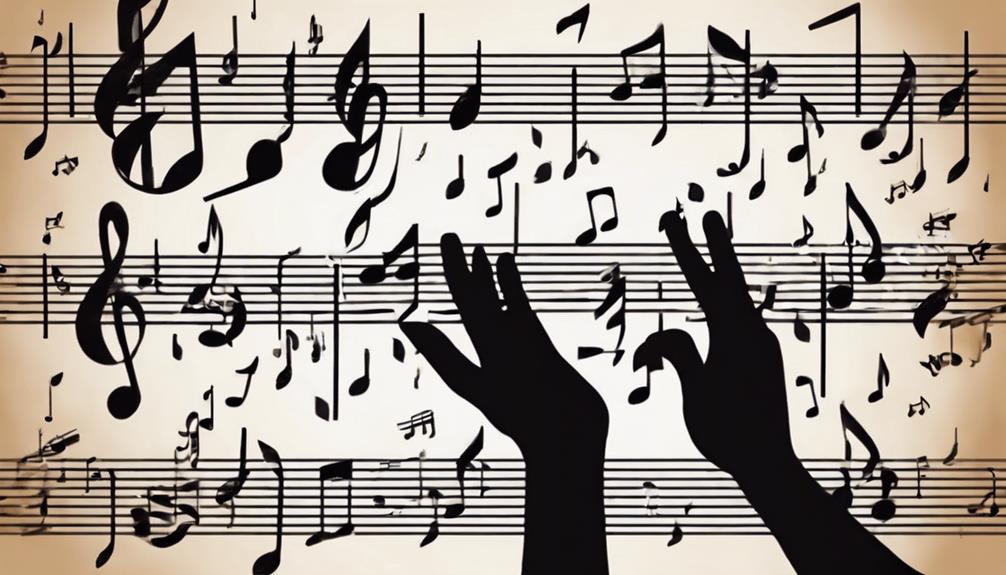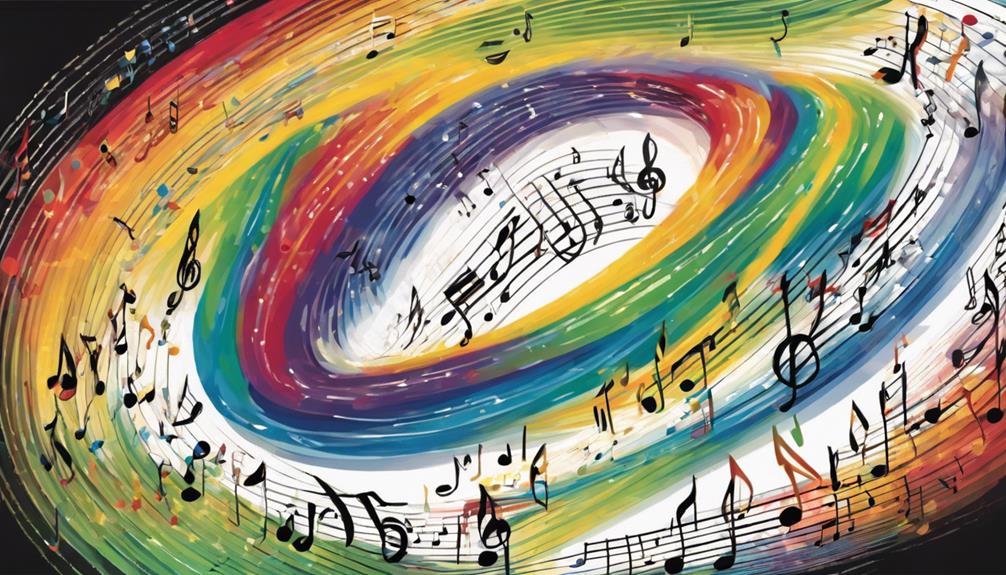No products in the cart.
Congratulations, you’ve stumbled upon the secret sauce of every hit song ever—music intervals. As a new producer, you’re likely eager to unlock the mysteries of crafting infectious melodies and harmonies that resonate with your audience.
Intervals, the space between any two notes, are more than just a technicality; they’re the essence of emotional expression in music. You’re about to learn how a simple ‘do-re’ can be the difference between a chart-topper and a song lost in the abyss of forgotten tunes.
By mastering minor seconds and tritones, you won’t just make music—you’ll sculpt sonic landscapes that can move mountains, metaphorically speaking. Stick around, and you’ll discover how these crucial elements can elevate your productions from sounding like just another track to becoming the track everyone remembers.
Key Takeaways
- Intervals define the space between pitches in music and are measured in semitones or tones.
- Recognizing intervals enhances proficiency with instruments and expedites melody crafting.
- Unison and octaves provide a framework for harmony and melody in music composition.
- Understanding minor seconds, major seconds, thirds, fourths, fifths, and tritones expands musical expression and creative horizons.
Understanding Music Intervals
To fully grasp the essence of music composition and performance, it’s essential to understand music intervals—the building blocks that define the space between pitches in a melody or harmony. Intervals, measured in semitones or tones, are pivotal for constructing scales and chords. As you delve into music creation, you’ll find that recognizing these intervals by ear and sight expedites melody crafting and enhances your proficiency with instruments like keyboards or piano rolls.
Exploring melodic intervals in different musical genres allows you to innovate within and across music styles. A minor third might evoke sadness in a blues ballad, while a major third could embody joy in a pop chorus. This understanding equips you to compose with intention, facilitating a direct line to your listeners’ emotions.
The relationship between intervals and emotional expression in music is profound. Familiarity with the main intervals—perfect unison, minor second, major second, minor third, and major third—enables you to manipulate mood and dynamic range. Interval ear training exercises are indispensable, helping you memorize names, distances, and the unique color each interval brings to your compositions.
Embrace these concepts to revolutionize your musical narratives and connect deeply with your audience.
Unison and Octaves Explained
Understanding unison and octaves is fundamental for any musician, as these intervals provide a framework for harmony and melody in music composition.
Unison occurs when two notes of the same pitch are played together. It’s not just about playing the same note twice; it’s about the powerful coherence unison can bring to your chord progressions, reinforcing your musical ideas and giving them a solid foundation.
Octaves, on the other hand, span 12 semitones apart. This interval is so crucial that it’s often used for octave doubling in orchestration, providing a fuller sound without altering the harmony. It’s like cloning the DNA of a note to fill the sonic space.
Here’s why these concepts matter:
- Unison in Chord Progressions: Creates cohesion and reinforces tonal stability.
- Octave Doubling in Orchestration: Expands the texture and richness of the sound.
- Framework for Harmony and Melody: Essential building blocks for innovative music production.
As you delve into music production, remember that understanding these intervals isn’t just about technical knowledge. It’s about harnessing these tools to craft soundscapes that are both familiar and pioneering, respecting tradition while also breaking new ground.
Learning Minor Seconds

As you begin to understand minor seconds, you’ll grasp the foundation of dissonance in Western music.
Integrating minor seconds into melodies can significantly alter the emotional impact of a piece, imbuing it with tension.
Understanding Minor Seconds
Delving into minor seconds, you’ll discover the smallest interval in Western music, spanning precisely one semitone and introducing a distinctive tension in musical pieces. These intervals are crucial for creating emotion and complexity, especially when you’re exploring different musical genres with minor seconds or incorporating them into chord progressions.
To keep you engaged, consider these intriguing aspects of minor seconds:
- They add dissonance that challenges conventional harmonies, pushing boundaries in innovative soundscapes.
- Minor seconds occur naturally in various scales, offering a gateway to exotic and unconventional melodies.
- Their use can characterize a genre, from the suspense in film scores to the edginess in certain electronic music subgenres.
Understanding minor seconds is a stepping stone to mastering musical expression and expanding your creative horizons.
Minor Seconds in Melodies
Incorporating minor seconds into your melodies injects a layer of tension and drama that’s essential for dynamic musical expression. These intervals consist of two adjacent notes a mere semitone apart, often resulting in a dissonant sound. As a new producer, recognizing dissonant intervals like minor seconds is crucial. They allow you to craft melodies that resonate with emotional depth and complexity.
To master their use, practice on a piano or your chosen instrument, paying close attention to the emotional weight they carry. When you’re incorporating tension in melodies, use minor seconds thoughtfully. They’re not just notes; they’re a narrative tool, capable of transforming a simple tune into a compelling story.
Harness the power of minor seconds to truly innovate and leave a lasting impact with your music.
Practicing Minor Second Intervals
To master the dissonant charm of minor second intervals, start by playing two notes that are a semitone apart on your instrument. This step is crucial for understanding dissonance in music and its emotive power.
As you dive into practicing minor second intervals, remember these key points:
- Feel the Tension: Embrace the unique tension that minor seconds introduce to melodies and harmonies.
- Consistent Practice: Regularly play minor seconds on a keyboard to develop your auditory recognition.
- Ear Training Apps: Utilize ear training tools to refine your ability to identify minor seconds by sound.
Incorporating these techniques into your routine will sharpen your musical intuition and allow you to innovate with the edgy soundscapes that minor seconds create.
Major Seconds and Their Role


As you explore major seconds, you’ll find they’re not just two semitones apart; they’re the cornerstone of musical structure and expression.
Grasping how major seconds shape melodies enables you to craft tunes that resonate with listeners, evoking a wide array of emotions.
When you harmonize with major seconds, you’re adding layers to your music, creating rich and complex soundscapes that captivate your audience.
Defining Major Seconds
Major seconds, composed of two semitones, are integral to crafting the bright and uplifting soundscapes found in various musical genres. As you dive into learning major second intervals, you’ll discover their versatility and how they can be used to create tension within a melody or chord progression.
To keep you engaged, consider these key points about major seconds:
- They add emotional depth, transitioning smoothly from one note to the next.
- Major seconds are pivotal in constructing major and minor scales.
- They offer a stepping stone to more complex harmonic structures.
Understanding major seconds is crucial for your growth as a producer. They aren’t just intervals; they’re the essence of musical expression, shaping the narrative of your compositions.
Major Seconds in Melodies
Harnessing the subtle tension of major seconds in your melodies can imbue them with dynamic movement and emotional depth, essential for captivating your audience. Exploring melodic tension through major seconds adds a layer of complexity that resonates with listeners’ emotions. Techniques for incorporating major seconds include using them to transition between phrases or to highlight a particular emotional moment within your piece.
Here’s a visual guide to help you imagine major seconds in action:
| Note | Interval | Effect |
|---|---|---|
| C | D (Major Second) | Anticipation |
| G | A (Major Second) | Urgency |
| E | F# (Major Second) | Brightness |
| A | B (Major Second) | Elevation |
| D | E (Major Second) | Movement |
Understanding the role of major seconds in melodies is crucial for crafting engaging and emotive musical phrases that resonate with innovation and depth.
Harmonizing With Major Seconds
When you harmonize melodies with major seconds, you’re layering sounds to create an expansive and optimistic audio tapestry that enhances your music’s emotional impact.
These intervals are pivotal for:
- Adding Color and Movement: Major seconds introduce a vivid spectrum to your harmonies, making your tracks stand out.
- Creating Tension: Strategically using major seconds can build anticipation and engagement in your compositions.
- Chord Progressions: Incorporating major seconds into chord progressions enriches the tonal quality, providing a unique auditory experience.
The Importance of Thirds


Grasping the concept of thirds is essential, as they form the backbone of chordal structures and significantly influence a song’s emotional tone. You’ll discover that the emotional impact of thirds in chord progressions and melodies is profound. Major thirds emit a bright, happy vibe, while minor thirds exude a more somber, reflective mood. This tonal dichotomy is critical for you, the producer, when you’re aiming to craft music that truly resonates with your audience.
Exploring different harmonic possibilities with thirds allows you to innovate and develop your unique sound. By integrating thirds into your compositions, you’re not just following a formula; you’re creating a rich tapestry of sound that can convey complex emotions and narratives. Here’s a table to illustrate the contrast between major and minor thirds:
| Interval Type | Emotional Quality | Use Case |
|---|---|---|
| Major Third | Joyful, Optimistic | Uplifting Choruses |
| Minor Third | Melancholic, Introspective | Intimate Verses |
| Augmented Third | Tense, Unsettled | Dramatic Bridges |
| Diminished Third | Mysterious, Unstable | Tension-building Pre-choruses |
Understanding these subtleties in thirds will enhance your musical palette, enabling you to design and execute compositions that are not only technically sound but also emotionally compelling.
Perfect Fourths and Fifths
Building on your understanding of thirds, let’s now turn our attention to the equally pivotal intervals in music: perfect fourths and fifths. These intervals are the building blocks of a vast array of musical innovations and are essential for you as an aspiring producer to master.
- Perfect fourths span five semitones, exuding stability and often leading to a sense of resolution within your music.
- Perfect fifths, encompassing seven semitones, are renowned for their powerful resonance, a staple across genres for their commanding presence.
- Understanding these intervals is key to creating rich and compelling chord progressions, vital for the depth of your compositions.
As you delve into creating tension with perfect fourths and fifths, you’ll find that these perfect intervals aren’t just conventional staples; they’re tools for expressing emotion and complexity. While a perfect fourth can introduce a subtle suspense before resolving, a perfect fifth might underpin your melody with undeniable strength. Incorporating these intervals into your chord progressions can transform a simple sequence into a captivating musical journey.
Embrace these intervals as you innovate, using them to weave together melodies and harmonies that resonate with listeners. Your journey in music production will be significantly enriched by the thoughtful application of perfect fourths and fifths.
Tritones and Dissonance


Venturing into the realm of tritones, you’ll encounter an interval that has shaped the sound of tension in music with its dissonant six half-tone span. This potent interval—spanning three whole tones—stands at the heart of dissonance, a fundamental concept that brings edginess and complexity to compositions.
In exploring dissonant harmonies, you must understand that dissonance isn’t simply a clash of sounds. It’s a tool for emotional storytelling, creating an anticipation that begs for resolution. The tritone splits the octave in half, producing a sound so unstable that it was once dubbed ‘Diabolus in Musica’ in medieval times, feared for its supposed nefarious qualities.
Today, the role of tritones in modern music is celebrated, especially in genres that thrive on innovation like jazz and rock. These genres often exploit the tritone’s tension to craft compelling musical narratives. As you experiment with tritones, you’ll learn to leverage their instability. They’ll push your arrangements beyond conventional harmonies, adding depth and character that can elevate your music.
As a new producer, embracing the tritone’s dissonant qualities is essential. It’s a rite of passage, one that unlocks creative doors and challenges listeners’ expectations, shaping the soundscape of the future.
The Beauty of Sixths
In the landscape of musical intervals, sixths stand out for their harmonious and emotive qualities, offering a counterpoint to the dissonance of tritones. As a new producer, you’re no doubt seeking innovative ways to enrich your sound. Sixths are your secret weapon, infusing tracks with a distinctive touch that can resonate across various genres.
By exploring interval variations with sixths, you’ll find they’re not just a singular concept but a dynamic tool:
- *Emotional Depth*: Sixths evoke warmth and nostalgia, perfect for crafting intimate moments in your compositions.
- *Harmonizing Melodies*: Use sixths to create lush, rich harmonies that enhance the texture of your music.
- *Chord Progressions*: Spice up your progressions by integrating sixths, adding complexity and a unique flavor.
Applying sixths in different genres opens up a world of creative expression, allowing you to stand out in a sea of producers. Whether you’re working on a soulful R&B melody or laying down a vibrant pop hook, sixths can add that layer of sophistication and elegance that elevates your music.
Embrace sixths, and let them inspire your innovative journey through sound.
Seventh Intervals Breakdown


As you delve into the world of seventh intervals, you’ll discover they’re pivotal in adding depth and complexity to your musical creations. These intervals, consisting of two stacked thirds, form the backbone of many harmonic structures, especially in genres like jazz.
Major seventh intervals span 11 semitones and infuse your soundscapes with a dreamy, ethereal quality that can evoke a sense of longing or unresolved emotion in your listeners.
Minor seventh intervals, on the other hand, contain 10 semitones and impart a melancholic and mellow character to your melodies. They’re frequently found in a variety of musical contexts, offering a softer contrast to their major counterparts.
When it comes to creating tension with dominant sevenths, these intervals are your go-to tool. Also comprising 10 semitones, dominant sevenths are essential in crafting that much-needed push-and-pull effect in your chord progressions. Their dissonance begs for resolution, driving your compositions forward and keeping your audience engaged.
Understanding how to manipulate seventh intervals, particularly in jazz, can immensely elevate your music production. Their ability to convey complex emotions and build harmonic interest will make your tracks stand out, ensuring you hit that sweet spot of innovation and technical prowess.
Frequently Asked Questions
What Is the Rule of Intervals in Music?
In music, the rule of intervals dictates the pitch distance between notes, crucial for composing and interval identification exercises. Mastering this enables innovative melody creation and enhances your technical music production skills.
What Are the 12 Intervals in Music?
You’ll explore semitones across 12 music intervals, enhancing composition through interval ear training. These foundational pitches are crucial for innovative melody and chord creation, advancing your production expertise.
What Interval Is Harry Potter?
You’re hearing the magic of interval recognition when the ‘Harry Potter’ theme rings out; that’s a perfect fourth, a cornerstone in creating memorable magic motifs in innovative compositions. It’s a staple in emotional musical storytelling.
What Are the Perfect Intervals in Music?
You’ll find the perfect intervals in music are unison, fourth, fifth, and octave. Mastering these through interval ear training sharpens your composition techniques, innovating and enriching your music’s harmonic foundation.
Conclusion
You’ve journeyed through the essentials of music intervals, grasping the significance of pitch differences from unison to sevenths. Now, with a sharpened ear and a solid theory base, you’re set to craft melodies that resonate.
Remember, practice breeds familiarity; so keep honing those skills. Embrace the nuances of each interval, and watch as your compositions gain depth and emotion.
Your next step? Dive into creating, experimenting, and finding your unique sound within the world of music production.




